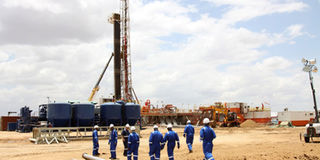Oil pipeline extension to South Sudan

PHOTO | FILE An oil rig in Turkana County. The initial design was for a pipeline running from Lamu to Lokichar, but it is now expected to cover 1,500 kilometres more to Hoima, near Lake Albert in western Uganda.
What you need to know:
- Construction may be delayed to include neighbouring countries, says Chirchir
- The initial design was for a pipeline running from Lamu to Lokichar, but is now expected to cover 1,500 kilometres more to Hoima near Lake Albert in western Uganda.
The tender for the construction of a pipeline connecting Turkana’s oil fields to Lamu Port will now be delayed to incorporate an extension to Uganda and South Sudan.
This will also push the completion date beyond the earlier scheduled November 2016.
“The initial design was for Kenya alone. We have now slowed down a bit to accommodate South Sudan and Uganda,” said Energy and Petroleum Cabinet Secretary Davis Chirchir.
The initial design was for a pipeline running from Lamu to Lokichar, but is now expected to cover 1,500 kilometres more to Hoima near Lake Albert in western Uganda.
“We are looking for a common transaction adviser to harmonise the new designs with the feasibility designs already done for the Uganda section,” added the CS.
The planned construction of the Lamu-Lokichar pipeline had gained momentum after Kenyan crude oil resources were said to have attained commercial thresholds, with the country seeking to lay out the infrastructure ahead of commercial production in the 2017/8 year as per the ministry’s production plan.
The new expanded crude oil pipeline is expected to be completed in 2017/18, as the facility has now been integrated into the Lapsset infrastructure projects.
Lapsset, at its inception, required a pipeline to be constructed from Lamu to the oilfields of South Sudan and a new refinery put up at Isiolo in northern Kenya, with the capacity to process 120,000 barrels per day of crude oil.
The pipeline’s export capacity and length will be determined by the design proposals to be forwarded by the pipeline engineering construction firms.
Toyota’s construction subsidiary, Toyota Tsusho Corporation, has drawn up preliminary designs for the project on the basis of Lappset, with several components in addition to the pipeline.




